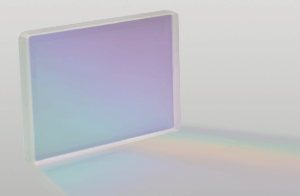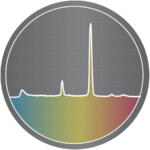 Many optical systems depend upon diffraction gratings to resolve light into desirable spectra by dispersing light into its component wavelengths. Conventional reflection gratings disperse polychromatic light into its constituent colours using a series of parallel rulings, engineered to have the desired dispersion efficiency profile by controlling the distance between these adjacent grooves and their individual angles. Interaction with this periodic structure causes interference between the rays of the incident beam, and results in dispersion of the output beam. Transmission gratings operate on the same basic principle of interference via a periodic structure, but instead transmit the diffracted light to allow more compact, lens-based optical designs.
Many optical systems depend upon diffraction gratings to resolve light into desirable spectra by dispersing light into its component wavelengths. Conventional reflection gratings disperse polychromatic light into its constituent colours using a series of parallel rulings, engineered to have the desired dispersion efficiency profile by controlling the distance between these adjacent grooves and their individual angles. Interaction with this periodic structure causes interference between the rays of the incident beam, and results in dispersion of the output beam. Transmission gratings operate on the same basic principle of interference via a periodic structure, but instead transmit the diffracted light to allow more compact, lens-based optical designs.
Manufacturers routinely strive to deliver gratings optimized for specific end-use scenarios, based on key parameters such as resolution, wavelength range, simultaneous bandpass, signal polarization, and decreased device footprint. Volume phase holographic (VPH) transmission gratings are a high-performance alternative to conventional ruled surface relief reflection gratings. In addition, our unique VPH technology offers considerable design flexibility to satisfy the needed performance objectives for a wide variety of applications.
Here, we review the top 5 most popular applications we see at Wasatch Photonics, and how our VPH transmission gratings excel at each.
-
Pulse Compression Gratings
 Pulse compression gratings are used in laser applications to compress or stretch ultrafast laser pulses with very high transmission at a single polarization. At Wasatch Photonics, we offer polarization-enhanced designs with high uniformity and low scattering for use when compressing laser pulses on either the femto- or picosecond regimes, all manufactured with the low wavefront error needed to maintain critical beam uniformity and maximize pulse power.
Pulse compression gratings are used in laser applications to compress or stretch ultrafast laser pulses with very high transmission at a single polarization. At Wasatch Photonics, we offer polarization-enhanced designs with high uniformity and low scattering for use when compressing laser pulses on either the femto- or picosecond regimes, all manufactured with the low wavefront error needed to maintain critical beam uniformity and maximize pulse power.
-
UV-Vis, NIR, and Raman Spectroscopy Gratings
 Transmission gratings with broad bandwidth capabilities across the ultraviolet-visible (UV-VIS) or near-infrared (NIR) regions of the electromagnetic spectrum are ideal for low light spectroscopic applications, offering greater detection of comparatively weak signals such as Raman scattering and fluorescence. A transmission configuration for these applications also facilitates more complete corrections of aberrations and a smaller, more thermally stable footprint.
Transmission gratings with broad bandwidth capabilities across the ultraviolet-visible (UV-VIS) or near-infrared (NIR) regions of the electromagnetic spectrum are ideal for low light spectroscopic applications, offering greater detection of comparatively weak signals such as Raman scattering and fluorescence. A transmission configuration for these applications also facilitates more complete corrections of aberrations and a smaller, more thermally stable footprint.
-
Hyperspectral Imaging Transmission Gratings
 Hyperspectral imaging is an evolved form of RGB multi-colour spectral imaging that detects a continuum of spectral lines simultaneously. This demands transmission gratings with the highest possible efficiency and low polarization dependence over an extremely broad wavelength range, as well as low wavefront error to preserve image clarity. Transmission gratings also enable straight pass optical designs for hyperspectral imaging that are compact and easy to align through the use of grisms – a combination of grating and prism.
Hyperspectral imaging is an evolved form of RGB multi-colour spectral imaging that detects a continuum of spectral lines simultaneously. This demands transmission gratings with the highest possible efficiency and low polarization dependence over an extremely broad wavelength range, as well as low wavefront error to preserve image clarity. Transmission gratings also enable straight pass optical designs for hyperspectral imaging that are compact and easy to align through the use of grisms – a combination of grating and prism.
-
Transmission Gratings in Astronomy
 Astronomical optics, more so than any other field of study, requires careful precision to lessen image distortion in extremely low light conditions in order to acquire detailed spectra from objects that may be light years away. VPH transmission gratings offer high line frequencies and broadband performance that can be angle-tuned to cover an even wider range. These are typically employed in large telescopes, where a suite of several large gratings (up to 30 cm in size) may be used to cover the desired spectral range.
Astronomical optics, more so than any other field of study, requires careful precision to lessen image distortion in extremely low light conditions in order to acquire detailed spectra from objects that may be light years away. VPH transmission gratings offer high line frequencies and broadband performance that can be angle-tuned to cover an even wider range. These are typically employed in large telescopes, where a suite of several large gratings (up to 30 cm in size) may be used to cover the desired spectral range.
-
OCT Imaging Transmission Gratings
 Spectral domain optical coherence tomography (SD-OCT) is a powerful technique used to visualize sub-surface tissue structures in three-dimensions using visible or near-infrared (NIR) light, and is most widely used for both medical diagnostics and non-destructive testing. OCT requires high signal-to-noise control over a broad bandwidth in order to generate high-resolution images over the full working depth of the system. Transmission gratings designed for OCT are optimized for high transmission efficiency at all polarizations, even at the bandwidth extremes, yielding reduced SNR roll-off and clearer, deeper OCT images.
Spectral domain optical coherence tomography (SD-OCT) is a powerful technique used to visualize sub-surface tissue structures in three-dimensions using visible or near-infrared (NIR) light, and is most widely used for both medical diagnostics and non-destructive testing. OCT requires high signal-to-noise control over a broad bandwidth in order to generate high-resolution images over the full working depth of the system. Transmission gratings designed for OCT are optimized for high transmission efficiency at all polarizations, even at the bandwidth extremes, yielding reduced SNR roll-off and clearer, deeper OCT images.
Transmission Gratings from Wasatch Photonics
At Wasatch Photonics, we develop and supply a wide range of high-efficiency transmission gratings that are in-stock for standardized applications. We are also experts in custom design and manufacture of unique transmission grating solutions to customer specifications. If you can’t find what you need in our online selection, we encourage you to contact us today to discuss your specific needs.



